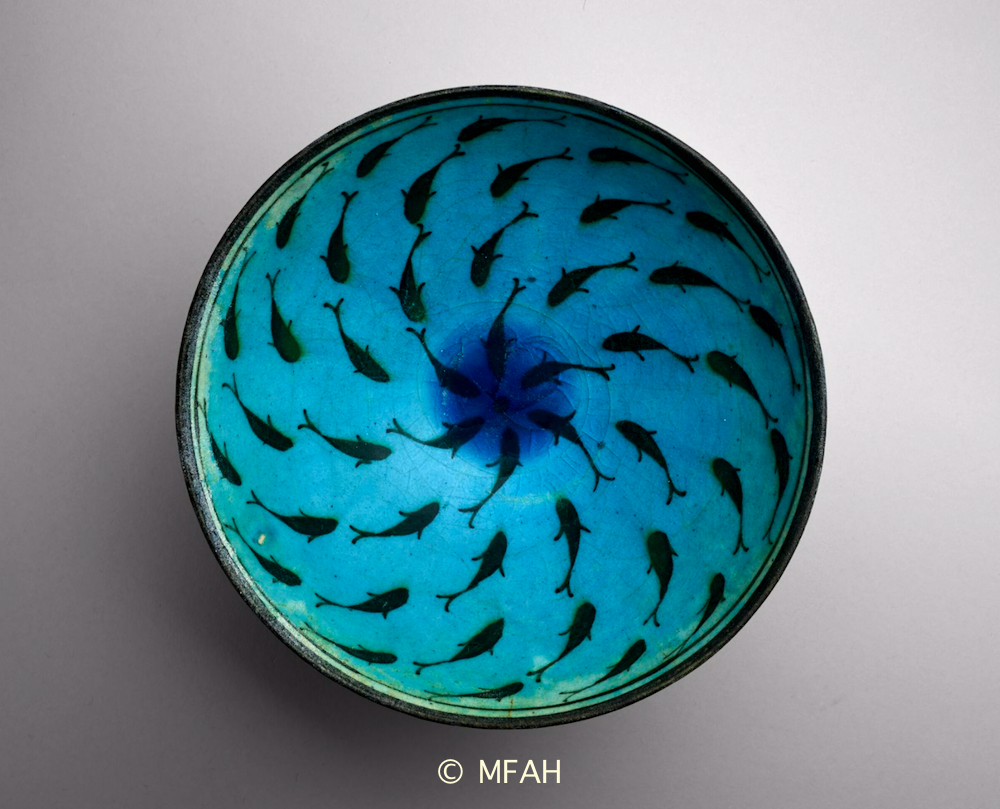By Pejman Akbarzadeh
Source: BBC Persian TV
The Fine Arts Museum of Houston with over 70,000 works, is one of the largest museums in the United States. The museum has organised a unique exhibition of Persian ceramics. The objects, however, are not from the museum’s own treasure but on loan from one of the largest private collections of Persian art. Most of this collection has never been exhibited in public before.
“Between Sea and Sky” is the title that the museum has chosen for its Persian ceramics exhibition. It refers to the history of blue and white ceramics between China and Persia and beyond starting in the 8th century. Persian artists used their own motifs to make these ceramics and in this process contributed to the diversity of the world of ceramics.
“We are so very proud to present the ceramics of Hossein Afshar’s collection at this exhibition” say Gary Tinterow, director of the museum. “For thousands of years, Chinese ceramics were sent around the world and imitated by many. In this exhibition attention has been paid to this art in Persianate lands and exchanges between these cultures” he says.
In the exhibition over 100 ceramics have been shown from a period of approximately 800 years: from the 9th-century, when Persia was part of the Islamic caliphate in Abbasid era, through the 17th-century under the Safavid dynasty.
“The inspiration for this exhibition starts with a single dish. From a distance it looks a typical Chinese dish but when we analyse that closer, in the center you see the “Lion and Sun” the ancient symbol of Persian kingship. This symbol has been embedded skilfully among the Chinese patterns. Actually in this single dish you can see hundreds of years of artistic exchanges between Chinese and Persian ceramics.” says Aimée Froom, curator of the exhibition.

The Persian blue and white ceramics were gradually transformed. The ceramic makers started to use stone-paste and cities like Kashan, Neyshabur and Kerman gained enormous fame in this field. The ending period in the exhibition is the Safavid era; a period which is known as the rebirth of the Persian Empire. Shah Abbas was a great enthusiast of ceramics. He was a patron of local artists in this field and also had a collection of Chinese ceramics himself.
“Safavid potters produced their works in many different techniques, of which ‘blue and white’ was just one of them. Their work was an integral part of the urban landscape in the capital city of Isfahan. It is documented in written records, tile panels and paintings”, says Aimée Froom, curator of the exhibition.
The efforts of Hossein Afshar, owner of this collection, to make a museum in Iran to present these works have not been successful up to now. His blue and while ceramics, which are among the finest, are on loan at Houston’s Museum of Fine Arts. The museum is going to publish a full catalogue of Hossein Afshar Collection’s Persian ceramics in 2022.
[The program was aired from BBC Persian TV’s news bulletin on 6 July 2021.]
ALSO WATCH:
No One Knowns about Iraqi Museum’s Persian Collection
Persian Treasure of Dagestan National Museum
World Premiere of “Taq Kasra: Wonder of Architecture” in London